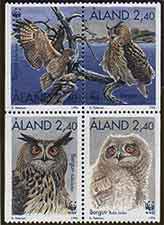| י 296) אוח עיטי | ||||||||||

| ||||||||||
|
:אח - אוח עיטי . אחד משני דורסי הלילה הגדולים בארץ . מצידי ראשו בולטות שתי ציצות אוזן ומשטח פניו מבדילים אותו מדורסי היום . צבעו חום צהבהב, מוכתם ומפוספס בצבע חום כהה , הפספוס צפוף בגב ודליל יותר בחזה. הקודקוד מפוספס בפסים שחומים . וזר הנוצות בפניו בולט. העינים גדולות וכתומות, המקור חזק ומאונקל . רגליו קצרות אך אצבעותיו ארוכות ובעלות טפרים גדולים וחדים. הזנב קצר ומעוגל במקצת . בית גידולו יערות מחטניים או רחבי עלים, חורשים, אזורים טרשיים, קניונים, שדות מרעה ומדבריות . בארץ יציב לא שכיח ברוב חלקי הארץ בעיקר במרכז והצפון ... ומלאו בתיהם אחים ... ישעיה י"ג כב' | ||||||||||
|
Subspecies and Distribution.
T. a. alba W and S Europe to N Turkey, also W Canary Is, and N Africa from Morocco to Egypt S to Mauritania, Algeria, Niger and NE Sudan. B. b. hispanus Iberian Peninsula B. b. bubo Europe from N Spain and Scandinavia E to W Russia. B. b. ruthenus C European Russia E to Ural Mts, S to lower Volga basin. B. b. interpositus from Romania and S Ukraine E to Volga delta, S to Middle East (S to C Israel and Jordan) and Iran. B. b. sibiricus from Ural E to R Ob, S to W Altai. B. b. yenisseensis C Siberia from R Ob to L Baikal, S to Altai and N Mongolia. B. b. turcomanus steppes between lower R Volga and R Ural, E to Transbaikalia, and S to Kazakhstan, NW China and W Mongolia. B. b. omissus Turkmeniya to W Cina B. b. hemachalana from Pamirs to Himalayas. B. b. nikolskii E Iraq and Iran, Afghanistan, and N and W Pakistan B. b. jakutensis NE Siberia. B. b. ussuriensis SE Siberia to NE China N Hokkaido and S Kuril Is. B. b. kiautschensis from W and C China E to Korea B. b. swinhoei SE China. םםםםםםםםםםםםםםםםםםםםםםםםםםםםםםםםםםם םםםםםםםםםםםםםםםםםםםםםםםםםםםםםםםם | ||||||||||
|
Descriptive notes.
The largest owl in the region, with long, broad wings, and pronounced ear-tufts. 60-70 cm, 1500-4200 g, wingspan 160-185 cm. Almost barrel-shaped, powerful bill and feet. flight recalls that of a buzzard. Nominate with buffy grey-brown facial disc with indistinct dark border, light buff eyebrows. Hindneck light buff-brown, mantle blacker, rest of upperparts warm buff-brown, all heavily streaked blackish. Flight-feathers barred buffish and dark brown, throat whitish, rest of underparts brownish orange-buff, paler on belly with long black droplets on chest. Races differ mainly in general coloration, strength of dark markings, and size. Races hispanus and ruthenus lighter and greyer than nominate. interpositus darker, more rufous, and sibericus very pale, creamy-wite below with contrasting streaks. Race yenisseensis darker, with yellower fround color. and hemachalana more light brown above, including mantle, turcomanus similar but greyer. nikolskii smaller and more rufous, and jakutensis dark, browner above, well marked below. Races kiautschensi rather small, very dark, streaking thin, and swinhoei small, strongly tinged rufous. Habitat. Mainly rocky country with cliffs and ravines, caves, patches of woodland, scattered trees of groves, generally in undisturbed wilderness areas, also open forest, taiga and other types of woodland. Forages also over open or sparsely wooded terrain, as well as floodland, heaths, farmed valley bottoms or levels with grassland, small arable fields, and even refuse dumps. Food and Feeding. Diet mostly mammals, from size of water vole to adult hares, and birds from size of jay to herons and buzzard, also occasionally amphibians, reptiles, fish, and invertebrates. Primarily nocturnal, somewhat crepuscular, even diurnal in summer at N edge of range, Hunts mostly from open perch, also in searching flight. Takes prey by surprise while flying close to ground or tree-tops. Sometimes makes systematic searches of rock crevices for roosting birds. Said also to take birds in full flight, to seize fish by plunging into water like Osprey. Breeding. Feb-Aug in north of range. Monogamous and solitary. Nest on sheltered cliff ledge or in crevice, in cave entrance, on ground on steep slope ro on flatter ground in taiga, sometimes in old tree nest of other species. 2-4 eggs, incubation 34-36 days, by female, fed by male. First breeding at 2-3 years. Movements. Resident in most of range, but juveniles disperse variabe distances, depending on food availability. In harsh winter conditions of N and C Asia, can be highly nomadic. Status and Conservation. Not globally threatened. Total European population in mid 1990's estimated at 25.000 pairs. Israel. In Israel subspecies B. b. interpositus. uncommon resident mainly through central and northern parts. |

| |||||||||
| HOME | NEXT | |||||||||


